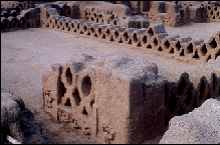« Arqueología »
El Niño Phenomenon

By means of archaeological and historical investigation, it has been possible to identify the presence of the "El Niño" phenomenon, throughout time: since 1100 B.C. until the last falling in 1983; thus Niños (documented) occurred of diverse intensities-some-real deluges, others "heavy showers" in the year 1100 B.C. and other in 1100 A.C., having a more continuous later sequence in 1578, 1678, 1701, 1720, 1728, 1748, 1763, 1770, 1791, 1804, 18014, 1817, 1819, 1821, 1828, 1832, 1837, 1845, 1864, 1871, 1877-8, 1884, 1891, 1911, 1918, 1925, 1940-1, 1945,-6, 1956-7, 1972-3, 1982-3 and finally we have to add that which is about to occur 1997-8 (Ecology and History, Lorenzo Huertas Vallejos, Chiclayo 1987).
For the knowledge of the people, it is to necesary to clarify precisely various things; in the first place that "El Niño" is not only sinonimous with biblical rains, but also with heat, plagues, etc. and in this case maybe those elements/events associated are more destructive and perjudicial for the economyu and society, than their rainfalls, although they are less immediatly felt. Once the showers have passed, nobody is interesed in what happens with the agriculture, livestock, etc. In the second place, as
Dr. Huertas has already said the phenomenon does not come with the same intensity enall the North Coast, and therefore as well as study "El Niño" in general, much enphasis should be given on the particular aspect of where it is going to hit with most force; although supposing that the effects will always be more to the north than the south, for something natural that is the length and area of the current and its area of action/influence. In the third place, although the given list would preoccupy anybody (so many Niños in succession would augur that we are going to have serius problems), having said that many of them did not stop at being heavy rains; but remained in the collective memory as greater memories, translated into a better social prevention; maybe the problem is that "El Niño" comes frequently, but not sufficiently to leave/engrave permanently the necesary wise lessons that would permit counteracting its effects (cleaning the riverbeds, forestation of the slopes of the hills, planting of appropiate plants, etc.).
On the occasion of "El Niño" of 1983, a classification was practiced of its intensity, in "Normal", "Moderate", "Misbehaved" and "Meganiño" (like the present in 1983); in the same way it was constructed that these Meganiños are every 1000 years approximately, and the others of lesser force at intervals of 100, 50, 25 and 10 years; although this is not as regular as clockwork. If it is well sure that a lot of study is lacking, apart from constrasting and crossing the data from the information already collected, we hop for the best in spite of the catastrophic forecasts, as "El Niño" does not mean the end of the world, that "El Niño" to be produced does not pass "Misbehaved"; and that its effects instead may be beneficialo and not destructive. Finally a reflection, there will not be a climatic event that does not affect us adversely, unless we foresee or are educated to confront it, counteract it and overcome it, and that like it or not, we live in this territory that is like that, called Perú.
By: Maritza Castillo Cotrina, Luis Yépez Pinillos Home Page
Home Page
 Indice
Retornar
Indice
Retornar
